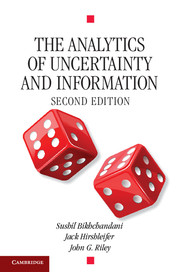2 - Risk Bearing
The Optimum of the Individual
Published online by Cambridge University Press: 05 August 2013
Summary
In this chapter, we address a basic problem in decision making under uncertainty: how should an individual select consumption across different states of nature so as to maximize his expected utility? The trick is to view consumption in one state of nature as a separate good from consumption in another state of nature. We then apply an indispensable technique in microeconomics – indifference curve analysis – to the problem to obtain the Fundamental Theorem of Risk Bearing. This theorem is directly applicable only when all state claims are available, i.e., for each state there is a good that pays if and only if that state obtains. However, trading in state claims is usually not a feasible option. Therefore, we generalize to a model with assets, where each asset is viewed as a vector of payoffs, one for each state of nature. This leads to the Risk-Bearing Theorem for Assets Markets. Next, we investigate risky choices made by an individual who cares only about the mean and standard deviation of his consumption. We end the chapter with a model of state-dependent utility.
The individual's best action under uncertainty – the “risk-bearing optimum” – involves choosing among prospects x ≡ (c; π) ≡ (c1, …, cS; π1, …, πS) where the cs are the state-distributed consequences and πs are the state probabilities. In the realm of the economics of uncertainty proper, before turning to the economics of information, the individual's probability beliefs π remain constant and so c1,…, cS are the only decision variables. In general, each cS represents the multi-good basket that the individual is entitled to consume if state s occurs. For simplicity, however, we will often think in terms of a single generalized consumption good (“corn”). Then cs would simply be the individual's state-s entitlement to corn if state s occurs, and the risk-bearing problem is how to choose among alternative vectors (c1,…, cs) of “corn incomes” distributed over states of the world. Unless otherwise indicated, when the symbol cs is described as representing “income” the implication is that we are using the simplified model of a single consumption good.
- Type
- Chapter
- Information
- The Analytics of Uncertainty and Information , pp. 46 - 85Publisher: Cambridge University PressPrint publication year: 2013



